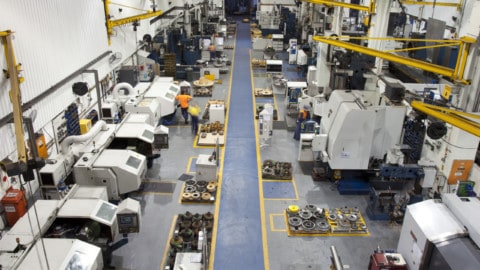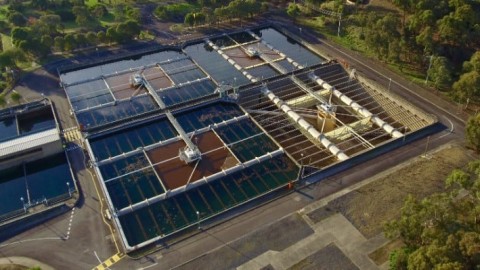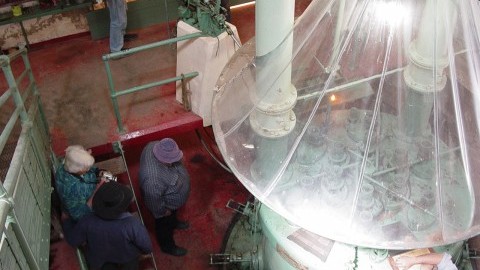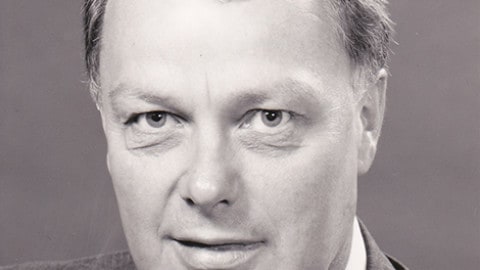Over 50 years ago, Alan Rowan began his career in the pump industry as a teenage apprentice. He then went on to enjoy a career spanning a wide variety roles at a number of different pump companies. Despite retiring from full time work in 2005, he has remained involved in the pump industry and provides consulting services, including commissioning pumps. He served as President of the PIA for three years and remains heavily involved in the organisation as a Council Member and is Executive Officer for Publications and Training.
Alan Rowan was born in Glasgow, Scotland. He left school at 16 and completed a Diploma in Mechanical Engineering at Stow College of Engineering while completing an apprenticeship.
How did you first get into the pumps industry?
By accident. I originally wanted to join the Merchant Navy as a cadet officer but, being colour blind, failed the eyesight test. My first job was as a shop boy in a Glasgow shipyard. I then got an apprenticeship at Drysdale & Co., a water pump manufacturer which was part of the Weir Group. I have been in the pump industry one way or another with a few short breaks for all of my working life.
An apprenticeship with Drysdale & Co allowed me to go to sea as a ship’s engineer. At the time in the UK, if you were in the Merchant Navy until you were 25, you did not have to do National Service. However, National Service was abolished before I finished my apprenticeship.
I did still plan to go to sea when I was finished; however, as soon as my apprenticeship was over Drysdales offered me a job as a trainee application engineer, which looked very interesting. I did that job until I left Scotland for New Zealand in 1967. This period of my life laid the foundation for the rest of my career in the pump industry, teaching me how all types of centrifugal pumps worked. Starting with selecting single pumps, I ultimately ended up putting together complex pumping systems.
What do you like about the pump industry?
Many years ago I was asked if working with pumps was boring, as they seemed to be quite simple machines. This is most definitely not the case. The wide variety of pumps and their applications always brings something new and interesting to learn. I started learning about pumps and their systems when I joined the industry over 50 years ago; and I am still learning today.
What other companies have you worked for during your time working in pumps?
When I left Scotland I worked in New Zealand for a couple of years for a small engineering consultancy, mainly working in the dairy industry. Our major project was the design of a new cheese factory including a new style of automated cheese making machine with associated machinery including a few pumps.
After this, I got my first taste of pump sales with Andrews & Beaven, selling to local industry. The remainder of my time in New Zealand was in sales, mainly in pumps, although I did spend an interesting two years designing and selling sewage treatment plants, ranging from small packaged plants to city sized plants (including plants for the cities of Rotorua and Hamilton). My last job in New Zealand was with Fletcher Engineering selling Ingersoll-Rand products, mainly pumps, where I was introduced to API process pumps and got a job offer from Ingersoll-Rand to come to Australia.
An interesting anecdote about my arrival in Australia is that I had taken two large orders, from Shell BP & Todd in New Plymouth and Reid Rubber Tyre Plant in Auckland, and a couple of smaller orders before I left. On visiting Ingersoll-Rand’s Dandenong plant I saw that 90 per cent of the pumps going through the plant were my orders.
I spent nearly ten years at Ingersoll-Rand and rose to National Sales Manager with a focus on the petrochemical industry, including supply of pumps to a number of pipeline projects. During this time I first got involved with the PIA (or APMA as it was known then), and was on the Technical Committee with well-known characters like Ron Astall, Geoff Daniels, Lex Torr and others. I worked on the Technical Committee from the late 70s until 1987. Around 1981 I became a Councillor and served on the council till 1992 including three years as President.
After my time at Ingersoll-Rand I joined Kelair Pumps as their Melbourne Branch Manager. After a year I transferred to Tasmania to run Douglas & Fraser who Kelair had just bought. I ran the company and the branch it became till 1997, overseeing the development of the business, acquiring new premises, overseeing the transition to a Kelair branch and setting up Kelair’s first service department outside Sydney.
On leaving Kelair I spent a short time with Blakers Pumps in Melbourne then spent over a year in the UK with my wife which allowed me to do a market survey for Southern Cross Pumps on their Ultimate Pump Systems.
We returned to Australia in late 1998 and I joined Southern Cross Pumps as their Ultimate Product Manager in June 1999 for 18 months. Then I moved to Link Pumps in a sales/engineering capacity until my retirement from full time work at the end of 2005.
Since then I have done consulting work including commission of pumps.
How has the industry changed during your time in it?
When I arrived in Australia in 1976 you could count the number of medium to large pump companies on both hands and the vast majority of pumps were Australian made. The market was dominated by Thompson of Castlemaine, Kelly & Lewis, Ajax, IEL (now United Pumps) and Ingersoll-Rand in the centrifugal pump market; Mono & Ebsray in positive displacement pumps and Warman for slurry pumps.
In the late 1970s many people left their major pump employers and started out on their own on the basis that they could offer a better, more personal service to industry and at the same time find better products from overseas. This contributed to the demise of Australian manufacturing, along with steep reductions in tariffs and the start of the rapid rise of pump imports to where it is now.
Of course, the reduction of tariffs over time in the mid-1980s spurred the growth of importation, leaving few companies which exclusively market for the Australian market – probably the only ones left are United Pumps and Warman.
Reflecting on the changes over the years, a job I was involved with in Tasmania with Kelair illustrated the changes. I called in on a pulp mill in southern Tasmania to find their multistage split case Australian-made log washing pump had died on them and was going to cost upward of $50k to fix. I was able to point out that we could get them a segment ring pump made in Europe much cheaper and at a similar delivery to the repair. As a result they bought the import. I did have to convince the plant engineer that modern segment ring pumps were easily maintained and did not have flat face sealing between the stages.
What was the most memorable moment in your career?
This is a difficult one but I think winning an order at Ingersoll-Rand for a new pump to pump crude oil from Moonie to Brisbane. This involved the supply of an API610 multistage pump driven through an API613 gearbox by a large Caterpillar crude oil fuelled engine, all to be delivered in 18 weeks ex works, which we achieved.
Another memorable moment happened at Kelair Pumps in Tasmania, where, in about 1994, head office decided all the branches should have their own service departments. This was a good idea for Tasmania, as customers were not keen on pumps being shipped off the island. Over a period of three to six months I brought together the equipment needed and hired a pump serviceman and started servicing pumps with 18 months to become profitable. We did it in less than a year.
Did you have a mentor at any time in the industry?
Over the years I had several. In Scotland when I started as an application engineer my boss then, Jimmy Gorman, gave me an in-depth education on the application and selection of pumps, and made sure I understood the intricacies of the affinity laws, NPSH and applying centrifugal pumps to handle the pumping of oil. Jimmy was a stickler for getting it right and taught always to make sure that the best pump we had available for the job was offered.
When I came to Australia to work at Ingersoll-Rand, guys like Richard Royds, Bob Haylock and Bob Paterson guided me on how best to work with the Australian pump industry. Richard Royds got me onto the APMA Technical Committee, Bob Paterson onto the Council, and the greatest pearl of wisdom Bob Haylock gave me was → to know when not to argue with a customer about a claim. At the time, the rule of thumb was if the claim was less than $400 then the argument was likely to cost you more than the claim and would end with bad feeling from the customer.
Tell me about some of the other personalities in the industry that you have worked with?
In this case, you can be spoilt for choice so I will stick with two.
First, Ron Astall. I first met and got to know Ron around 35 years ago when we were both on the APMA Technical Committee. Over the years Ron’s knowledge of pumps and their applications has always impressed me, and he is always happy pass his knowledge on, usually in is normal self-deprecating style with a few of his bad jokes thrown in. I can’t count the number of mean Scotsman jokes he has told me.
The second is John Link, whom I have known for 25-30 years. John has always run his own business — mostly in pump hire, sales and service, with a good deal of flair and his own unique style. If you are looking for a problem solution from left of field John is the one to ask, and they often work.
What are the most significant developments you have witnessed in the industry?
Without a doubt the most significant development has been the change from mainly Australian made products to the clear majority of pumps now sold in this country being imported, along with the blossoming of smaller pump companies who import their own product and sometimes distribute pumps from the major importers such as Grundfos.
Another development I consider significant is what I would call the modernisation of pump control systems. We have transitioned from simple automatic starters controlled by float or pressure switches to sophisticated electronic controls with variable speed drives and soft starters working with SCADA and PLC controls. Even pressure switches and float switches can be replaced by pressure transducers and ultrasonic level controls.
Are you still involved in the industry today?
Very much so; I have been on the PIA Council for a second stint since around 2003 and also serve as Executive Officer for Publications and Training which involves looking after PIA’s publications, keeping them up to date and publishing them. 2013 saw the latest editions of the Pump Technical Handbook and Pipe Friction Handbook printed, the latter with minor update, while the Technical Handbook underwent a major update with new chapters on Positive Displacement Pumps, Energy Efficiency and Troubleshooting, with many other chapters being substantially upgraded. At present I am working on an installation and commissioning training course which will have theory and practical components, and is designed to prepare people to confidently install and commission pump sets.
What are the greatest challenges facing the pump industry? What does the future hold for pumps?
Today there is a fantastic range of excellent pumps of all types and sizes available in Australia and to me there are two great challenges that the industry faces. Firstly, to convince the buyers of pumps to stop buying on lowest dollar and start evaluating pumps and their systems for their efficiency, both from the point of
power consumption and cost of operation over the life of the pump, its
driver and its system.
The second big challenge is training and retaining people so that they are willing to make a career in the pump industry. Today there are too many employers (both within and outside our industry) who want to hire trained personnel only and leave the training to others. Over the years I have found that it is next to impossible to pick up staff with any worthwhile pump experience. Unless you get really lucky, you have to put some sort of training program in.
There are plenty of good basic training courses available; however if that is not enough you need follow up with practical supervised experience until the trainee has got the basics right and then make sure they keep on learning. In my view it takes five to ten years to make a good pump guy who has a reasonable knowledge of pumps and the industry, but most of all understands that he is on a lifelong learning process.
As to the future, the one thing for sure is that the world is not going to stop needing pumps. So the future will be bright if the industry accepts and overcomes the challenges we have been discussing.
What advice would you give young people in the pump industry?
The principal advice I would give is to realise that while pumps are relatively simple machines, due to the wide variety of types and styles and the many variations of construction materials, learning about pumps and selling them is a lifelong adventure which is very rewarding.
What do you like to do in your spare time?
I love fishing on Port Phillip Bay and have a small boat from which I fish as often as I can between early October and late May. I am afraid last summer I didn’t get out as much as I would have liked for various reasons, but I plan to use this winter to get my boat and gear in order and get out more often in the coming summer before I get too old.
















